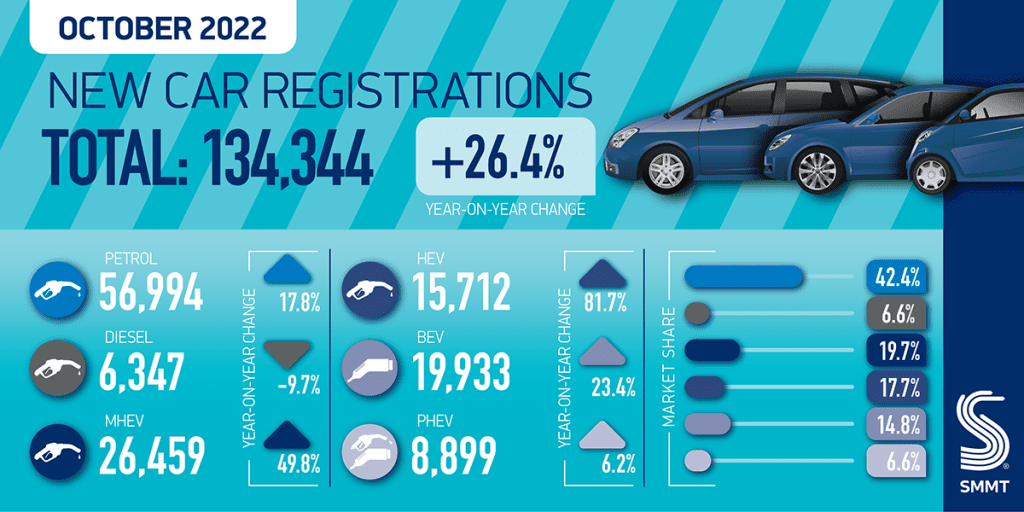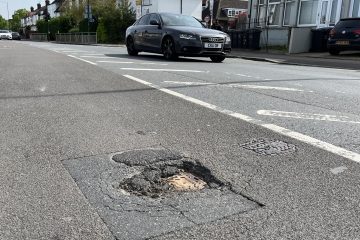The UK’s new-car market recorded a third straight month of growth in October, although the recovery may not be enough to help the market avoid recording the weakest year of registrations since 1982.
The October 2022 registrations figures from the Society of Motor Manufacturers and Traders (SMMT) show that registrations rose by 26.4% in October 2022, with 134,344 units taking to the UK’s roads. This is in part to a displacement effect, with orders delayed by the ongoing automotive supply crisis finally being fulfilled. Additionally, October 2021 was particularly disappointing, with deliveries falling by exactly the same amount (26.4%).
Year-to-date figures are still down 5.6% on 2021, highlighting the heavy losses at the start of the year, with three months of growth unable to bring the market back into positive territory. The SMMT also highlights that the market is still down by a third on pre-pandemic levels

With carmakers struggling to find supplies of crucial components, such as semiconductor chips, orderbooks are becoming increasingly backlogged, with some waiting up to a year to receive their new car. As registrations only count when the vehicle is delivered, and not purchased, this year’s results have been hit by a displacement wave that is expected to continue into 2023, where the SMMT believes further recovery will occur.
Electric vehicles help October 2022 registrations growth
Growth in October was driven primarily by large fleet registrations, which grew 47.4% to 67,911 units, while those by private buyers rose 7.4% to 62,714. Smaller businesses recorded a 108.6% increase although, at 3,719 units, this is a small segment of the market.
Plug-in vehicles, including plug-in hybrids (PHEVs) and battery-electric vehicles (BEVs) helped registrations to grow in October. These models, particually BEVs, have been popular in recent years, as carmakers shift away from emission-heavy internal combustion engines. PHEVs saw growth of 6.2% to 8,899 units registered compared to last year, while BEVs increased their registrations 23.4% to 19,993.
However, BEV uptake grew by less than the overall market for the first time since the pandemic, meaning October is the first month to see BEV market share fall year on year since May 2021, mainly attributable to the aforementioned supply challenges.
Deliveries of hybrid electric vehicles (HEVs), meanwhile, improved dramatically by 81.7% to account for more than one in 10 new cars, as supply was prioritised for a raft of popular new models. Overall, electrified vehicles accounted for one in three registrations, while more than a fifth (21.5%) came with a plug.
The decline of diesel halted in October, with the fuel-type increasing its registrations for the first time in many months, albeit by 2.4% to a total of 11,813 vehicles. Most of these were mild hybrids, with the technology holding an 8.8% market share, making it the fourth most popular fuel-type. Year-to-date, there are 79,412 fewer diesel vehicles coming to UK roads, equating to a drop of 37%.
Petrol sales increased by 26.6% in the month, with these cars accounting for 58% of the UK’s market during October.
The Ford Fiesta, which is soon to end production, took the top spot in the best-selling car list for the month with 4,230 registrations, just two units ahead of the Nissan Qashqai (4,228).
Economic and supply crisis impacts market
The SMMT highlights that ongoing supply chain shortages, surging inflation and a growing cost of living crisis have led to a 2.2% downward revision of the market outlook for the year, with 1.566 million registrations now anticipated. This puts 2022 on course to be the market’s toughest year since 1982.
More positively, demand for electric vehicles is anticipated to result in a plug-in market share of 21.9%. Overall market recovery is anticipated to continue through 2023, with an outlook of 1.808 million units and plug-ins accounting for 26.7% of registrations next year.
Electric vehicle provisions needed
Such growth underlines the importance of increasing public chargepoint provision. At the start of October 2022 the UK had 34,637 public standard, rapid and ultra-rapid electric vehicle charging devices, with 1,239 new rapid chargers and 5,023 new standard chargers installed during the first nine months of the year.
With 249,575 new plug-in registrations during the same period, just one new standard public charger has been installed for every 50 new plug-in EV registrations. At this rate, it is unlikely that government’s ambition for 300,000 public chargers by 2030 will be met.

“A strong October is hugely welcome, albeit in comparison with a weak 2021, but it is still not enough to offset the damage done by the pandemic and subsequent supply shortages,” commented SMMT Chief Executive Mike Hawes.
“Next year’s outlook shows recovery is possible and EV growth looks set to continue but, to achieve our shared net-zero goals, that growth must accelerate and consumers given every reason to invest. This means giving them the economic stability and confidence to make the switch, safe in the knowledge they will be able to charge – and charge affordably – when needed. The models are there, with more still to come; so must the public chargepoints.”
With stretched infrastructure and the cost of living crisis both having the potential to undermine future uptake, government’s Autumn Statement, set for 17 November, provides an opportunity to stimulate demand and deliver both economic growth and net-zero progress. Further measures to mitigate energy costs in the longer term for consumers and businesses would give greater confidence. Now is not the time to raise motorists’ costs, which would likely stoke inflation and damage broader government revenues from new car sales.
“A long-term fiscal commitment to zero emission motoring would do much to stimulate investment and demand. EV drivers’ top complaints are, invariably, cost and charging anxiety so reducing VAT on public charging to bring it into line with home charging would level the playing field for drivers unable to install a home chargepoint.”




You must be logged in to post a comment.